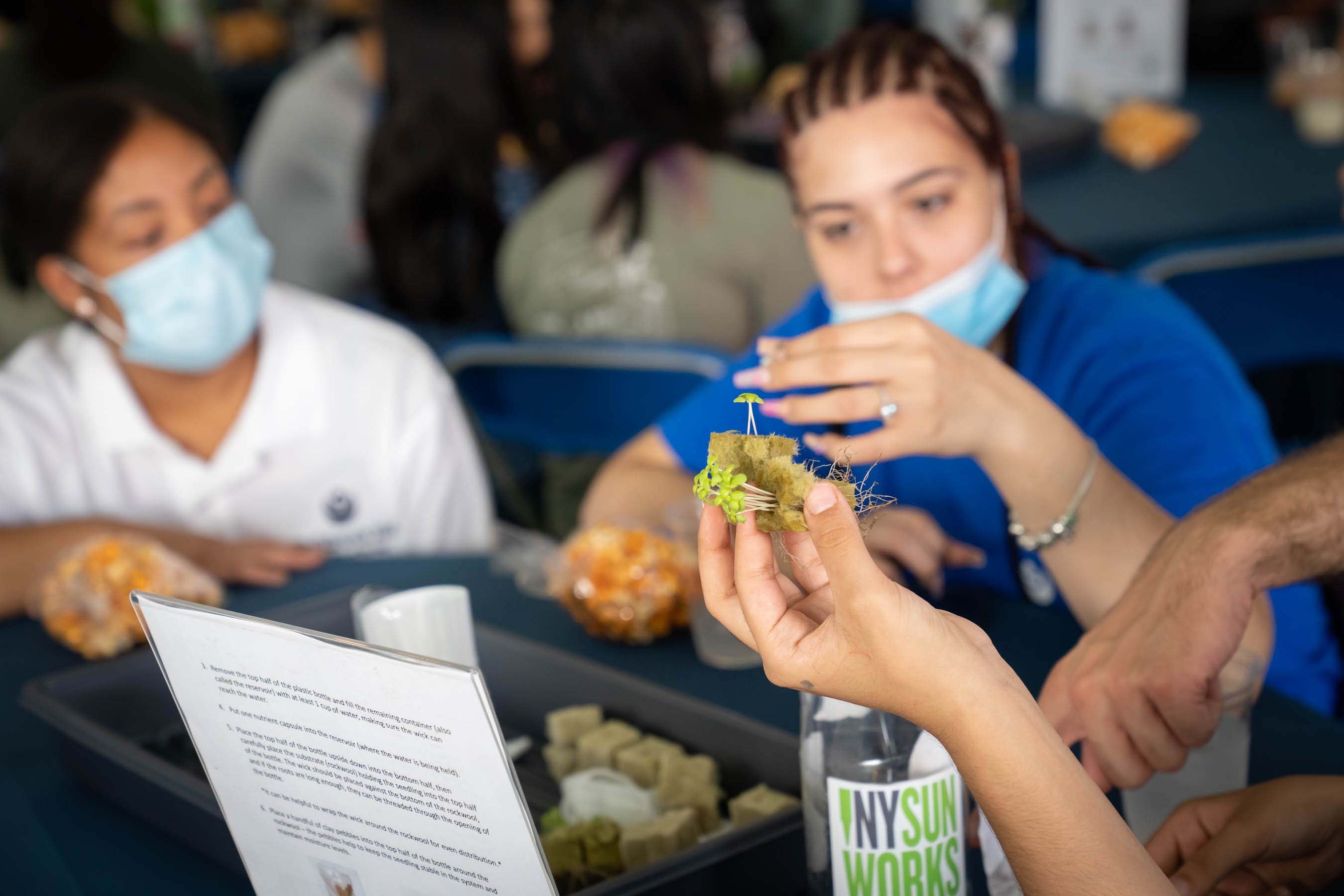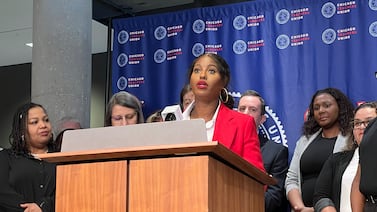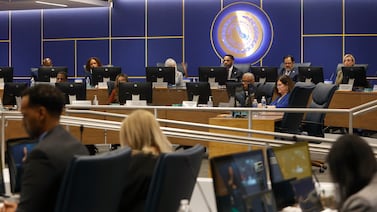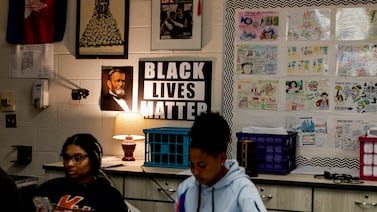When Ariful Anup was looking for a job last summer, he applied for the city’s Summer Youth Employment Program.
Like more than half of last summer’s applicants, the 17-year-old didn’t get picked. But this summer, after city officials dramatically expanded the program, his luck changed.
New York City already had the nation’s largest youth jobs initiative. This summer, the Adams administration increased the number of youth who get paid to work or learn to 100,000, from nearly 75,000 last year, framing it as a way to curb violence. The program pairs youth ages 14-24 with paid jobs or youth-based learning opportunities.
Ariful’s job filing paperwork for Queens Community House — a nonprofit contracted to pair youth with summer jobs that also takes on some kids of its own — wasn’t very challenging, but he learned to use Excel and was able to start saving up for a car, he said. He didn’t want to leave his friendly co-workers.
“I’m very interested in this job, but unfortunately it’s just a summer program,” said Ariful, who graduated from Newtown High School in the spring.
In the three years before this summer, 156,500 youth on average applied for a spot, but less than half of applicants, on average, got a job, according to annual city reports. (That excludes 2020 when the program was slashed because of the pandemic.)
This year, 167,000 youth applied, and about 60% of applicants were paired with a job.
Ahead of this year’s expansion, providers wondered how difficult the rollout would be. But as the program closes out, officials and providers alike describe the expansion as largely successful.
Providers have pointed to a few issues that should be improved going forward — such as having enough talented staff on hand —especially if the city is planning to grow the program any larger down the road.
An all-time record
To pair youth with jobs, the city contracts with community-based organizations who find employers that will take on youth for the summer. Their paychecks are covered by the city.
In 2021, the first year after the pandemic started, providers said it was a huge challenge to find work sites. Employers were recovering from the pandemic and didn’t have the bandwidth to supervise youth workers.
This year’s expansion meant spinning up a larger program and finding more work sites. To help providers, the city took on a larger role in finding jobs for youth, using “our relationships, the mayor’s relationships,” said Valerie Mulligan, deputy commissioner of youth workforce programs at Department of Youth & Community Development, which oversees SYEP.
Providers noticed. Lowell Herschberger, the director of career and education programs at the nonprofit Cypress Hills Local Development Corporation, said he’s been critical of DYCD’s previous management of SYEP. But for this summer, he “can’t overstate” how much the agency cooperated with organizations and advocates, including on finding employers.
“They made introductions with us for a number of work sites where they said, ‘Hey, we had this contact. Would you like to work with them?’” Herschberger said, who added that his organization set youth up across 70 different work sites. “That was one thing that advocates have called for, and I think there was marked improvement on that.”
Ultimately, the city placed youth across 17,000 work sites, an all-time record, compared with 14,525 sites last year, said Mark Zustovich, a spokesperson for DYCD.
DYCD officials also touted offering more spots to youth living in public housing, as well as those who are involved with the court system, are homeless or are in child welfare programs. About 20,000 such youth were offered spots this year, compared to 14,000 last summer, officials said. (That’s about 2 percentage points higher than the last summer.)
Scrambling to find remote jobs
Vaccination status presented a unique challenge this year for providers. DYCD required youth participants to be vaccinated for COVID-19 if they were planning to work in person – applying the same city policy that requires public and private sector workers to be vaccinated.
That meant finding remote work for unvaccinated youth, even if work sites didn’t care about vaccination status, providers said.
Herschberger estimates that about 100 of their nearly 900 participants were unvaccinated, causing Cypress Hills to “scramble” for more remote jobs.
Queens Community House, where Ariful worked, ran into the same issue. Their organization spun up their own virtual work site for their unvaccinated applicants. Some of those young people decided not to participate.
“For some of them, parents were like, ‘We want them to go out and do real-time work,’ and our hands were tied,” said Trudy Lennan, who helped run the organization’s youth workforce programs.
Youth typically report more negative feedback about remote work or project-based opportunities, Herschberger said. However, having remote work was a nice option for the kids who were vaccinated but couldn’t work in person because they were going to spend the summer out of town, or because they had other responsibilities to juggle, such as caring for younger siblings, he said.
“For some youth, it really works,” he said. “While I say that we can’t just rely on remote stuff, I do think there’s a place for that.”
At Queens Community House, one of the biggest issues this year was the tight five-day deadline for getting youth to hand in the documents required to enroll in the program.
Some participants had difficulty finding all their documents or information, such as a social security number, because they live with guardians who aren’t their parents. Or, since recent physicals are required, some struggled to schedule doctor’s appointments in time.
Staffing woes continue
Some providers continue to worry about hiring enough staff.
Queens Community House had several unexpected staff vacancies. That meant quickly finding, hiring, and training “quality” staff during a labor market shortage, said Alex Sumpter-Delves, division director of youth workforce for Queens Community House.
A longer window of time to plan would have been helpful, she said.
“I know many of my peers in these circles have echoed the same exact challenges: being able to quickly onboard people and prepare for a high-volume program,” Sumpter-Delves said.
Herschberger’s organization didn’t take on many more youth participants this summer, but they’re aiming to pair 300 more young people with jobs next summer if the program stays this size.
The seasonal nature of SYEP means it’s staffed with temporary employees who seek other jobs once they leave. That means his organization loses workers once they have become good at the job. Herschberger tries to get his seasonal employees to stay on for the year round programs they run at schools, which later expand into the summer. But as of Monday, Herschberger still hadn’t heard how many of those year round slots they’ll be funded for — meaning he can’t offer a full-time job to one of his best workers from the summer just yet.
If the program is going to expand, Herschberger hopes the city will consider investing in more year round programs for youth, or even just inform organizations sooner about how many of those slots they’ll be responsible for so that they can plan in advance.
“Eighty percent of our workforce was brand new just for this summer, and I really don’t want that to be the case next year,” Herschberger said.
Officials declined to confirm whether the program would still offer 100,000 slots next year or if the program would grow. However, Mulligan, from DYCD, said this year was a “huge step forward” and that “it proved to us that we could do more than we had ever done before.”
This was the second year of SYEP for Bruce Valdez, 17, who also did office work for Queens Community House. The biggest lesson he learned was the discipline of waking up early every morning before heading to work, he said. Asked what he’s doing with his paycheck, he said he’s putting it in a brokerage account – under his older brother’s name for now because of age restrictions.
“If you put money into a brokerage account, it makes money for you,” said Valdez, who will be a senior this fall at Newtown High School. “I don’t want to work a 9-5 for the rest of my life, so you gotta start young, right?”
Reema Amin is a reporter covering New York City schools with a focus on state policy and English language learners. Contact Reema at ramin@chalkbeat.org.






